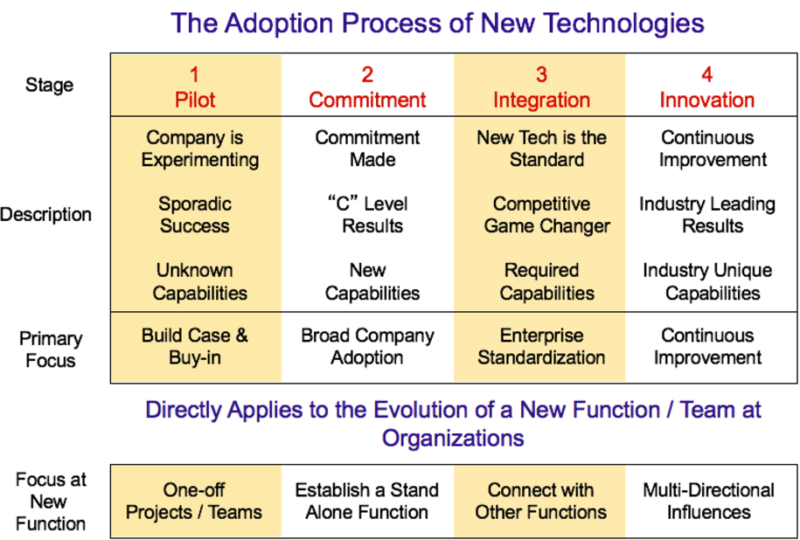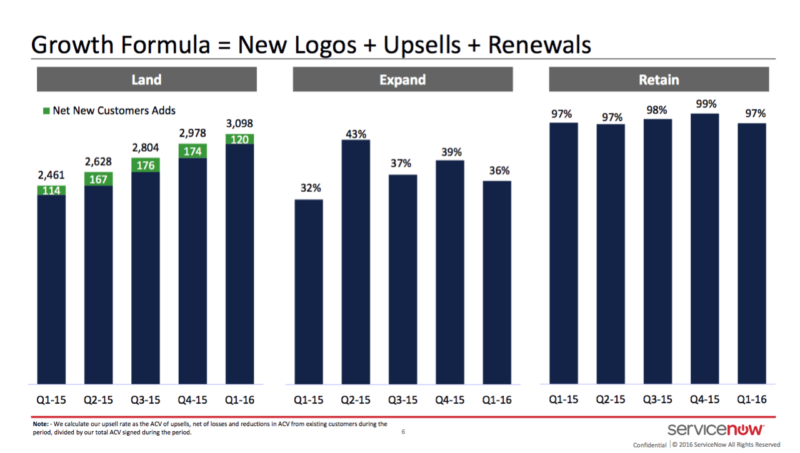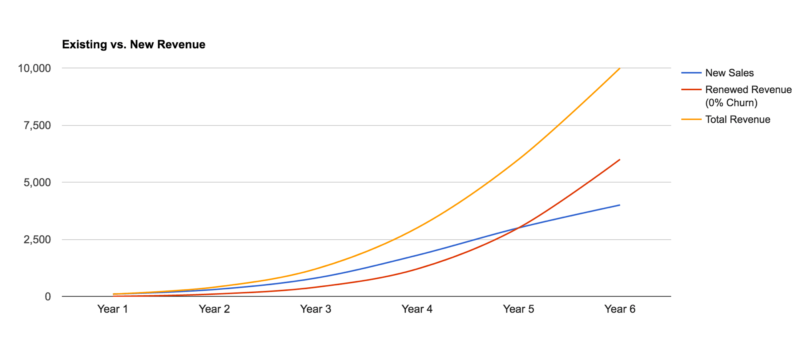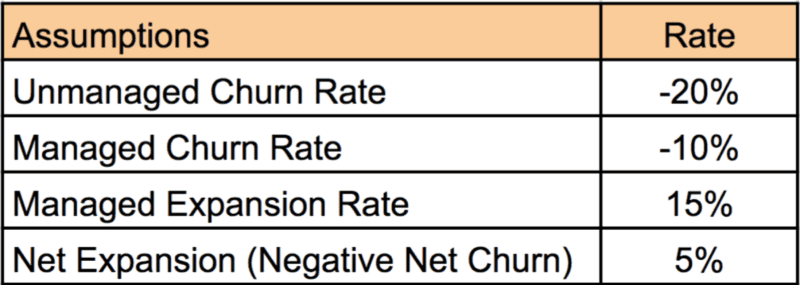This post was co-authored by Tal Tsfany.
Synopsis
The evolution of the Customer Success (CS) profession is reaching an inflection point. What started with a few innovative companies and executives looking for ways to support the unique needs of vendors and customers in the SaaS world has evolved in the past few years into a highly sophisticated, stand-alone function with a seat at the executive table, established charters, specific metrics, well defined processes, clear roles and responsibilities and an evolving set of dedicated technological tools.
As the profession matures, though, the focus of the Chief Customer Officer (CCO) has to shift from building a stand-alone function to integrating it with the rest of the organization. The interaction between CS and Marketing teams is particularly ripe for such integration. This post will highlight the need for such an integration and the methods to frame it.
The Dating Scene is Changing in the C-Suite
Customer Success is exploding. Its growth is directly attributed to the shift of businesses to the subscription economy where customers commit not only fewer upfront investment, but also fewer upfront resources in their relations with a vendor. Consequently, it is the vendor’s responsibility to invest more resources and expertise into the relationship to ensure a profitable ratio between the lifetime value (LTV) of the customer and the cost of their acquisition (CAC).
On a positive note, SaaS vendors now have a level of visibility to their customers’ behavior and usage of the product or service that was never possible before. These two facts (the need to invest more and the ability to have more data) have propelled the massive growth of this new function: Customer Success (CS for short).
You may say that the CCO has come of age and is ready to start dating… They are now the new comer in the C-Suite and like any new comer, their arrival changes the dynamics within the C-Suite. Some relations have to change, others need to be created from scratch.
A Short History of the Evolution of the Customer Success Function
Almost every organization experiences an evolution in their attitude towards and development of Customer Success. The early days of the CS function in an organization are usually focused on experimentation and validation. The concept of CS has to be proven and a business case built for the organization to invest in it. Once the concept is proven, companies start to make incremental commitments to CS teams and functions. This second stage is characterized by efforts to define goals, develop processes, hire appropriate people and implement technologies needed for the function. The cycle could be summarized as: develop capabilities, show results (ROI), grow team and capabilities, show higher results, and so on.
Many companies are reaching a higher level of CS maturity. A number of industry resources report that more than 90% of companies surveyed have a stand-alone CS team and more than 50% of them now report directly to the CEO.
But, to further evolve their functions, Chief Customer Officers can learn from tested and proven methodologies for adoption of new technologies. The chart below provides one such example with an added bottom row to illustrate the specific implication for a new business function.

CCO’s need to assess where their company’s CS function is at, maturity wise, and act accordingly. By now, most companies are at the commitment phase, working on strengthening their internal functions with better tools, enhanced processes, refined goals, etc. But, those who are mature and have strong CS teams, must look at the next phase. To further evolve their functions, CCOs need to progress to the phase of integrating their function with other business functions. This is critical in order to create the synergies required to fully assimilate a new CS function into the organization, while streamlining cross-functional metrics and processes.
How the CCO Became the VP Sales BFF
Early on, the role of the CS team was to “bridge the gap” between the promises made by the sales team and what the product could deliver. Consequently, the key focal points for every Head of CS were the Head of Sales and the Head of Engineering or Product. The interactions with Heads of Sales were around the hand-off process and understanding what was sold and promised to customers. Interactions with Heads of Engineering/Product were around evaluating product matches and resolving the gaps via support or product enhancements. In fact, defining the working relations between Sales, Product and Customer Success has been a major topic of focus at every CS conference we’ve been to in the last few years (and there have been many of those!).
As the CS function has matured, more interaction has developed with the CFO to ensure the financials (renewal, churn, upsell, cross-sell, gross margin, etc.) are being planned, forecasted and executed appropriately. In recent CS events and forums, the discussion has evolved toward the role CS plays in driving the key financial metrics of the company. Publicly traded SaaS companies (such as ServiceNow, shown in this post by Tomasz Tunguz) started to report CS metrics such as change in MRR from existing customers, as well as net and gross churn. This has been a strong sign of maturity for the CS function.

How the CMO Became the VP Sales BFF
In parallel, Marketing has been the one profession that arguably evolved the most in the corporation in the last decade. From a predominantly qualitative function focused on branding and positioning, it has evolved to a highly quantitative, measured and scientific function that measures results in terms of impact on revenue. It now calculates ROI on just about every facet of its work. For a Marketing person, not knowing what Marketing Qualified Leads (MQL) is equivalent to a teenager wanting to date, but not having Tinder on their phone… Sales, by the way, is going through the same process.
This (quite fantastic!) focus on results has led CMOs to work very closely with the Heads of Sales. If the objective is to increase revenue, it is critical that the Head of Sales and Head of Marketing agree on the goals for the Marketing function and align on actions needed to follow through on them. After all, the output of the Marketing team’s work is the input for the Sales team. Shared goals like number and/or dollar value of MQL and SQL in “the top of the funnel” are very common among Sales and Marketing teams.
Sophisticated firms now determine the budgets and size of their Marketing teams based on those “handshake” metrics, just like they derive the size and resources of the Sales team based on its sales quota capacity.
Why the CCO Should be Interested in Becoming the CMO BFF
The two trends described above — the changes within SaaS companies toward more focus on growing revenue from existing customers, coupled with the increased maturity and sophisticated result-orientation at both the Marketing and Customer Success functions — are now creating an opportunity to take Marketing and CS a step forward to Customer Success Marketing.
For Customer Success teams to create impact, communication channels need to be developed in order to effectively help customers derive more value from their products and/or services. This should result in more opportunities to expand the relationships and increase the revenue from the existing customer base. It is the one metric every Head of CS cares most about: getting to Negative Net Churn or in its more positive form – Net Expansion.
Many CS organizations have been developing capabilities to create and deliver content to their customers. “Customer Marketing” is a hot topic in Customer Success forums and conferences these days and “one-to-many programs” or “customer campaigns” are almost must-have functionality for every Customer Success Management platform solution.
But, this internal tool and team development has caused many CS teams to struggle in executing on effective engagement campaigns — why? Because developing the full set of capabilities for such an effective and efficient function is a profession by itself and it’s called… Marketing.
Customer Marketing Is a Marketing Function, Not a Customer Success One
So, with the underlying assumption of the effectiveness of division of labor, our thesis is that CS organizations should NOT create their own Marketing team, but rather team up with Marketing to design, execute and measure customer engagement initiatives.
Both of us in our roles as CS executives have built CS Marketing functions. The result? Duplication of efforts and tools and sub-optimal customer communication experiences. Just try to rationalize Marketing and CS automated emails pre and post-sales and you’ll understand what we’re talking about.
But, saying that marketers should care about CS isn’t enough. We need to explain why and how much they should care. Since Marketing teams are goal oriented, calculated and revenue-focused, we should take the same approach.
Last year, Redpoint Ventures’ Tomasz Tunguz suggested that, “CSM teams can generate more revenue than sales teams.” SaaStr’s Jason Lemkin went further to claim that, “Customer success is where 90% of the revenue is.”
We want to take this concept a step further and layout a basic model to calculate how much of Marketing’s time and budget should be spent on ensuring CS meets its goals of minimizing churn and maximizing expansion.
Let’s start with the basics:
1. The Reason Why (the CMO Should Care)
If we look at a growing SaaS company with 0% churn, we can see that as the company grows its customer base, the ratio between revenue from new customers (New Sales) and revenue from existing customers (CS-Managed) changes.
A simple example is a company that generates $100K in new sales in year 1, $300K in year 2, $800K in year 3 and so on.

And here is the graph, just to make it visual.

We can see that from year 5 onward, CS is managing the same or more revenue as sales is generating.
The CS Marketing Budget (the CMO Should Allocate)
Now that we understand that the CS team is accountable for a significant portion of the business, let’s try and calculate what portion of the Marketing budget should be allocated to CS. Our calculations assume that the product or service has a level of inherent value that some customers will renew their contracts even if the company had no CS team at all, just like some new customers will sign up even if the sales team is small or nonexistent. The work that these teams do, each in its own domain, accelerates and enhances the success of the company in generating revenue from new prospects and existing customers respectively.
Let’s assume that with no CS activities, the company will experience a 20% annual churn rate and that with a fully-functioning CS team, it will experience a 10% churn rate. Also, a strong CS team will be able to expand the customer base’s revenue by 15% with up-sell and cross-sell, generating a (negative) net churn rate of -5% annually, meaning growing revenue from the existing customer base by 5% . This will allow us to calculate the incremental value of the CS team over the business “inertia.” Now we can compare the impact of the CS team to the new revenue that is enabled by the Sales team. We assume 100% inbound sales, all enabled by Marketing. Yes, we’re making life easier for Sales here… 🙂
Based on the above, the ratio between the incremental impact of CS and the new revenue enabled by Sales (again, assuming all sales is Marketing-enabled) looks something like this:


As you can see, by year 5 the incremental revenue generated by the CS team accounts for more than a quarter of the revenue the company influences and approaches 40% in year 6. This is a relatively simplistic calculation, of course. But, it is imperative that companies start thinking of their marketing budget allocation in such a way.
Quantifying the ratio of the Marketing budget that should get allocated to CS Marketing needs to be adjusted by every company according to the nature of its business. For example, the impact of higher retention on word-of-mouth lead generation.
CMOs should adjust their programs to generate engagement with existing customers. To that end, they need to first understand what customers are interested in and what they need during the different stages of their life cycle. Then, they need to combine that with their changing attitudes and sentiments toward the company. Sounds familiar? Well… it’s just like Marketing’s regular job with prospects…
Marketing teams should treat existing customers like a segment in their target market mapping. Like any segment, this one has some unique characteristics that differentiate it from other segments. For example, the amount of knowledge customers have about the products and the extent of the relations already in place between the companies. These unique qualities should define the characteristics of targeted CS Marketing programs. We have great faith in the ability of Marketing teams to figure out this segment. After all, Marketing experts know how to deal with different customer segments – they do that all day long.
Why the CCO Needs to Make the First Move
Companies are already identifying the need to grow their Customer Marketing efforts — according to “The 2017 State of Customer Marketing,” a recent research of CEOs and heads of Marketing departments conducted by Kyone and published on the Influitive website, 93% of organizations expect that their Customer Marketing efforts will take on greater importance in 2017, and 62% plan to increase their staff or budgets in the Customer Marketing area. But, while over 90% of respondents acknowledge that Customer Marketing is important, only 73% measure its results, and only 61% are satisfied with the results of current Customer Marketing efforts (among those, smaller companies reported lower satisfaction and lower impact of such activities). Clearly, there is a lot of opportunity here.
More importantly, we strongly believe that the owner of making that shift happen, should be the Chief Customer Officer (CCO). CCOs need CMOs the same as VP Sales do. It is the responsibility of the CCO to establish the relationship and cross-departmental processes between CS and Marketing and pull (lure…) the CMO to assist them.
As suggested above, the role of the CCO must continually shift as its function matures. After establishing its function and enabling it with people, processes and technologies, the next phase of the evolution is to integrate it with other functions. A team works better when each sub team executes on the tasks it specializes in. Just like the Head of Sales does not try to develop Marketing functions within Sales, so must the CCO avoid building a duplicate Marketing team within CS. Instead, he or she should work with the CMO to establish clear joint-goals, the means of measuring them, and the appropriate resources in order to achieve them.
It is possible that the above analysis results in a recommendation to increase the Marketing budgets in order to support Customer Success Marketing. It is also possible that the CCO and the Head of Sales will have to “wrestle” for their share of an existing Marketing budget. Either way, the CCO’s should build a clear ROI for their marketing needs if they want to be effective in getting more marketing dollars.
Why the CMO Needs to “Swipe Right”
So far, we’ve talked about the motivation that the CMO should have in driving existing customer base growth together with the CCO. But there is another reason why the CMO should “Swipe Right” (for those of you removed from the dating scene – this means accepting the invitation…) – and that is the impact this relationship can have on new logo growth through Advocacy Marketing.
Ample analysis shows that Customer Advocacy is a very powerful means to both increase the effectiveness and reduce the cost of generating leads. References, referrals, case studies, user generated content, reviews, blog posts and more from happy existing customers are very effective in adding credibility to the company’s claim about their solutions and the value they provide customers. Mark Organ of Influitive, put it succinctly: “While most companies have to spend a fortune on CAC, the best companies mobilize their advocate communities and have a low CAC – and a higher LTV at the same time, because every customer helps to win more customers.”
By working extra closely with the CCO, CMOs can not only generate value in supporting revenue growth within existing customers, they can also at the same time support their MQL goals with new prospects.
Conclusion
To sum it all up, a well-structured and budgeted Customer Success Marketing is the next step in the evolution of companies towards customer centricity. After the first wave of centralizing the management of existing customers under one executive function came the second wave with an array of metrics, roles and responsibilities, new CS technologies, and best-practice processes. The next frontier is strengthening ties with other functions in the organization and embedding the CS team into the working processes of the rest of the corporation. The opportunities of closer relations between Marketing and Customer Success are big and yet achievable. The CCO should ask the CMO out and the CMO should swipe-right… This is one of the key challenges and opportunities for Chief Customer Officers in the years to come.

